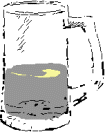 When
most people think of hefeweizen, they probably think of it in conjunction
with summer. After all, what’s more refreshing in hot weather than a tall
foamy glass of delicious, crisp and tart wheat beer? In the winter time,
though, I must confess that even I, a lover of weissbier all year long,
don’t drink as much of the stuff as I do in summer.
When
most people think of hefeweizen, they probably think of it in conjunction
with summer. After all, what’s more refreshing in hot weather than a tall
foamy glass of delicious, crisp and tart wheat beer? In the winter time,
though, I must confess that even I, a lover of weissbier all year long,
don’t drink as much of the stuff as I do in summer.
I suspect that is why the fine folks at Germany’s renowned Erdinger brewery came up with the idea for Erdinger Schneeweisse back in 1997. After all, what better way to sell wheat beer in winter (or snow to an Eskimo?) than by adorning it with a highly festive name and label for the holidays.
Literally, Schneeweisse means “Snow white”, but this beer is not named for any fairy tale my friends. In this case, the weisse refers to weissebier, or wheat beer. Weisse is German for white, but it is also colloquial for wheat beer because the beer has a white-yellow hue.
Erdinger says of the beer on their website:
Slightly darker and stronger than classic Erdinger Weissbier "with fine yeast", our new "Schneeweiße" wheat beer is a welcome change during the cold winter months - the perfect time for a little indulgence!
Erdinger Schneeweiße uses the first malts from the summer harvest. It's not until mid October that the wheat beer specialty develops its amber color and spicy flavor - a result of its long maturing period. "Schneeweiße" goes particularly well with hearty food - something not uncommon during the Christmas season!
The Germans helped to inspire the modern American craft beer tradition of specialty winter brews with their Weihnachtsbier, or Christmas beer. Most of those that I have run across have been bocks, but I’ve always enjoyed Schneeweisse as a special holiday treat as well.
Erdinger Schneeweisse has an alcohol content of 5.6% by volume, a bit highter than Erdinger Weissbier which clocks in at 5.3%. I paid $3.49 for a half liter bottle, a good deal these days as beer prices go.
Erdinger Schneeweisse pours to a bright yellow-whiteish color with a towering head of loosely packed foam and a scintillating nose of vanilla and clove. Taking a sip, I get the lightest bit of malt up front followed by tart crackery wheat, vanilla, clove and banana. The beer finishes light and refreshing with a tart wheaty snap. Excellent Weissbier here, as fresh as the new fallen snow and perfect for the season.
Is this beer all that much different from good old Erdinger Weiss? Not appreciably. But the gorgeous label and cap alone, festooned as they are with a bucolic snow covered scene, are worth the price of admission alone. Then too, any excuse to enjoy a wheat beer in winter is a good one, wouldn’t you say?
And remember, try a new beer today, and drink outside the box.
*Pricing data accurate at time of review or latest update. For reference only, based on actual price paid by reviewer.
(B)=Bottled
(D)=Draft

